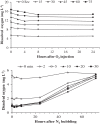Oxygen stress reduces zoospore survival of Phytophthora species in a simulated aquatic system
- PMID: 24885900
- PMCID: PMC4028286
- DOI: 10.1186/1471-2180-14-124
Oxygen stress reduces zoospore survival of Phytophthora species in a simulated aquatic system
Abstract
Background: The genus Phytophthora includes a group of agriculturally important pathogens and they are commonly regarded as water molds. They produce motile zoospores that can move via water currents and on their own locomotion in aquatic environments. However, zoosporic response to dissolved oxygen, an important water quality parameter, is not known. Like other water quality parameters, dissolved oxygen concentration in irrigation reservoirs fluctuates dramatically over time. The aim of this study was to determine whether and how zoospore survival may be affected by elevated and low concentrations of dissolved oxygen in water to better understand the aquatic biology of these pathogens in irrigation reservoirs.
Results: Zoospores of P. megasperma, P. nicotianae, P. pini and P. tropicalis were assessed for survival in 10% Hoagland's solution at a range of dissolved concentrations from 0.9 to 20.1 mg L(-1) for up to seven exposure times from 0 to 72 h. Zoospore survival was measured by resultant colony counts per ml. Zoospores of these species survived the best in control Hoagland's solution at dissolved oxygen concentrations of 5.3 to 5.6 mg L(-1). Zoospore survival rates decreased with increasing and decreasing concentration of dissolved oxygen, depending upon Phytophthora species and exposure time. Overall, P. megasperma and P. pini are less sensitive than P. nicotianae and P. tropicalis to hyperoxia and hypoxia conditions.
Conclusion: Zoospores in the control solution declined over time and this natural decline process was enhanced under hyperoxia and hypoxia conditions. These findings suggest that dramatic fluctuations of dissolved oxygen in irrigation reservoirs contribute to the population decline of Phytophthora species along the water path in the same reservoirs. These findings advanced our understanding of the aquatic ecology of these pathogens in irrigation reservoirs. They also provided a basis for pathogen risk mitigation by prolonging the turnover time of runoff water in recycling irrigation systems via better system designs.
Figures


Similar articles
-
Zoosporic tolerance to pH stress and its implications for Phytophthora species in aquatic ecosystems.Appl Environ Microbiol. 2009 Jul;75(13):4307-14. doi: 10.1128/AEM.00119-09. Epub 2009 May 8. Appl Environ Microbiol. 2009. PMID: 19429548 Free PMC article.
-
Carbon Dioxide as a Potential Water Disinfestant for Phytophthora Disease Risk Mitigation.Plant Dis. 2013 Mar;97(3):369-372. doi: 10.1094/PDIS-09-12-0844-RE. Plant Dis. 2013. PMID: 30722360
-
Survival of Phytophthora alni, Phytophthora kernoviae, and Phytophthora ramorum in a simulated aquatic environment at different levels of pH.FEMS Microbiol Lett. 2012 Jul;332(1):54-60. doi: 10.1111/j.1574-6968.2012.02574.x. Epub 2012 May 3. FEMS Microbiol Lett. 2012. PMID: 22506539
-
Phytophthora zoospores: From perception of environmental signals to inoculum formation on the host-root surface.Comput Struct Biotechnol J. 2020 Nov 21;18:3766-3773. doi: 10.1016/j.csbj.2020.10.045. eCollection 2020. Comput Struct Biotechnol J. 2020. PMID: 33304469 Free PMC article. Review.
-
Fatal attraction: How Phytophthora zoospores find their host.Semin Cell Dev Biol. 2023 Oct-Nov;148-149:13-21. doi: 10.1016/j.semcdb.2023.01.014. Epub 2023 Feb 13. Semin Cell Dev Biol. 2023. PMID: 36792439 Review.
Cited by
-
Diversity and community structure of cyanobacteria and other microbes in recycling irrigation reservoirs.PLoS One. 2017 Mar 16;12(3):e0173903. doi: 10.1371/journal.pone.0173903. eCollection 2017. PLoS One. 2017. PMID: 28301562 Free PMC article.
References
-
- Blackwell E. Species of Phytophthora as water moulds. Nature. 1944;153:496.
-
- Deacon JW, Donaldson SP. Molecular recognition in the homing responses of zoosporic fungi, with special reference to Pythium and Phytophthora. Mycol Res. 1993;97:1153–1171. doi: 10.1016/S0953-7562(09)81278-1. - DOI
-
- Duniway JM. Water relation of water molds. Ann Rev Phytopathol. 1979;17:431–460. doi: 10.1146/annurev.py.17.090179.002243. - DOI
-
- Erwin DC, Ribeiro OK. Phytophthora Diseases Worldwide. St Paul, MN, USA: APS Press; 1996.
-
- Hong CX, Moorman GW, Wohanka W. Buettner C (eds.): Biology, Detection and Management of Plant Pathogens in Irrigation Water. St. Paul, MN, USA: APS Press; 2014.
Publication types
MeSH terms
Substances
LinkOut - more resources
Full Text Sources
Other Literature Sources

